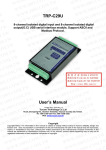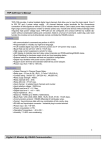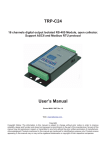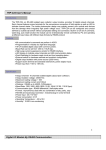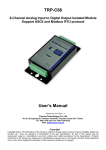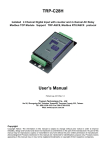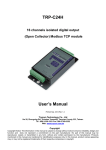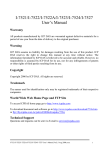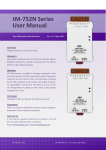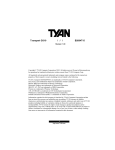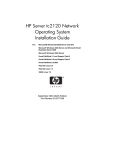Download TRP-C29U User's Manual
Transcript
TRP-C29U 8-channel isolated digital input and 8-channel isolated digital output(O.C) USB serial interface module, Support ASCII and Modbus Protocol. User’s Manual Printed Sep. 2014 Rev 1.2 Trycom Technology Co.,Ltd No.35, Zhongxing Rd., Guishan Township, Taoyuan County 333, Taiwan. Tel : 886-3-350-3351 Fax: 886-3-350-3352 Web: www.trycom.com.tw Copyright Copyright Notice: The information in this manual is subject to change without notice to improve reliability, design and function and does not represent a commitment on the part manufacturer. No part of this manual may be reproduced, copied, or transmitted in any form, without prior written permission by the manufacturer. Products mentioned in this manual are mentioned for identification purposes only. In this manual, product names appearing may or may not be registered trademarks of their respective companies or copyright. 1.Introduction TRP-C29U is USB to serial interface that provides with 8 optical isolated digital input channels and 8-channel digital output open collector. All channel features screw terminals for convenient connection of field signals as well as LED’s to indicate channel status. Input channels are equipped with 3750Vms DC isolation . For easy user access, TRP-C29U can enter configuration mode and self-test mode with outer dip-switch. TRP-C29U support both ASCII and Modbus protocol, with a full set of command, dual watch-dog, and auto reset function. the module can be bi-directionally remote controlled by PC in ASCII or Modbus RTU protocol. 1-1.Features USB directly power supply input. System get a seriall com port when USB plug in. Support ASCII and Modbus RTU protocol. Supports baud rates from 1.2Kbps to 115.2 Kbps. All 8 channels digital input ca be used as counter. Digital input signal with 3750Vrms isolation protection. Dual watchdog: Module’s firmware, host computer traffic. LED for each channels working status. DIN rail and panel mount support. Driver Support: Android/Win8.1/Vista64/32,Windows 98/ME/2000/XP/WIN 7/CE5.0~7.0, and Linux, and Mac OS. Configured and self-test by outer dip-switch. 1-2.Specifications Built-in USB 2.0 to serial bridge. Input channel: 8 digital input channels. Input optical isolation: 3750 Vrms. Input logical level 0 +/-1V (max). Input logical level 1 +/- 4.0V ~ +/-30V. Digital Input can be used as counter channel:8 Input counter: Dec 0~65535(max) or Hex 0000~FFFF (max). Input impedance: 3Kohm. Input Counter frequency: 100Hz. Input distance: 500M (max). Digital output Maximum voltage: +/-30V. Digital output Maximum current: 100 mA. Digital output isolation: 3750Vrms. Communication interface: USB to serial . Communication speed: Baud rate from 1.2kbps to 115.2Kbps. Dual watchdog: Hardware reset circuit, module and host operating status. Signal LED: Power on, all channels. Power supply: Directly input from USB. Connection type: Screw terminal, accepts AWG #12~32 wires Power consumption: 1.2W. Operating environment: -10 to 50℃. Storage temperature: -20 to 70℃. Humidity: 10-90% Non-condensing. Dimension: 151mm X 75mm X 26mm . Weight: 400g. 1-3. Panel Layout 1-4.Block Diagram 1-5. Pin Definitions DI5 Digital Input CH 5 DI6 Digital Input CH 6 DI4 Digital Input CH 4 DI7 Digital Input CH 7 DI3 Digital Input CH 3 DO7 Open Collector output CH7 DI2 Digital Input CH 2 DO6 Open Collector output CH6 DI1 Digital Input CH 1 DO5 Open Collector output CH5 DI0 Digital Input CH 0 DO4 Open Collector output CH4 IN_COM External Voltage for Digital Input DO3 Open Collector output CH3 NC None DO2 Open Collector output CH2 NC RS485+ DO1 Open Collector output CH1 NC RS485- DO0 Open Collector output CH0 NC Input Voltage 10~30V EXT-GND External Voltage Ground for DO NC Input Voltage Ground EXT-PWR External Voltage Power for DO 2-1. Communication Wiring 2-2. Wire Connection 3. USB to serial Driver Install *Notice: When you finished the TRP-C29U USB to serial driver install, the O.S will detect dual serial ports. For TRP-C29U there only one set of serial port can be use and the other one set of serial port is non-function 1. Power on your computer and boot to Windows. 2. Put the driver CD in the CD-ROM then select the driver of O.S you want (See figure1) Fig.1 3-1 .Install Vista32/64 driver Find “MSSetup.exe” utility which in the Vista64 folder. Double click on MSSetup.exe to start the installation process. Make sure that the User installing the driver must be a member of the Administrator group on the system You will get a “User Account Control” window saying “An unidentified program wants access to your computer”. Click on Allow to continue installing the Driver. You will get an installation window as below, press “Install” button to install the drivers for High-Speed USB Multi Serial Device. During the installation process, a “Windows Security” warning message pops up informing that "Windows cannot verify the publisher of this driver software". Ignore the warning message by clicking on the option “install this driver software anyway”. You will get the above message two times and you have to select “install this driver software anyway”. The utility displays a message stating “Installation completed”. Use “Exit” button to complete the driver installation. 3-1-1.TRP-C29U Device Installation & Detection: Connect TRP-C29U to the USB Host controller of the PC using a USB cable. The first time you plug-in the cable into the USB port, Windows will start installing the device driver software. You can see the installation status at the pop-up message of system tray. After installation, the pop-up message says “Your devices are ready to use”, Device driver software installed successfully. TRP-C29U device detection can be confirmed by checking at the Device manager. Check for “ High-Speed USB MultiSerial Compound Device” under Universal Serial Bus controllers and you will find “MosChip High-Speed USB Serial Port (ComX)” under the category Ports (COM & LPT). Here ‘X’ in ‘ComX’ represents the serial port number. You can see the same in the figure below. 3-2 .Install XP driver Find MSSetup.exe and MSUninst.exe which in the folders for Win XP/2K and Win98/ME operation system. Use “MSSetup.exe” utility to install the driver. Double click on the utility to start the installation process. Press “Install” button to install the drivers for High-Speed USB Multi serial Device. During the installation process, a warning message will popup informing the user that the software being used has not passed the Windows Logo testing. You can ignore the warning message by clicking on the option “Continue Anyway”. The utility will display a message stating “Installation completed”. Use “Exit” button to complete the driver installation. Connect TRP-C29U to the USB Host controller of the PC by using a USB cable. The first time you plug the adapter into the USB port, Windows will bring up the "Found New Hardware Wizard" window to guide you through the initial configuration process. Select the option “No, not this time” and click on “Next” button to continue. The following wizard helps you install the software for “High-Speed USB Multi Serial Compound device”. Select the option “Install the software automatically” and click on “Next” to proceed further. As specified in earlier section, a warning message will popup informing the user that the software being used has not passed the Windows Logo testing. You can ignore the warning message by clicking on the option “Continue Anyway”. The following window conveys that the OS had finished the software installation for “High-Speed USB Multi Serial Compound Device”. Click on “Finish” to complete found new hardware wizard. Follow the same steps as explained for “High-Speed USB Multi Serial Compound Device” for the second port installation . Select the option “Install the software automatically”…… “Continue Anyway”⋯⋯ The following wizard indicates that the OS has completed installing the software for the first serial port. Continue the same process for installing the rest of the serial ports. TRP-C29U device detection can be confirmed by checking the Device manager. Check for “High-Speed USB Multi Serial Compound Device” under Universal Serial Bus Controllers and “High-Speed USB Serial Port (Com X)” under the category Ports (COM & LPT) Now the TRP-C29U Device is ready to use. 3-3 .Uninstall XP driver Use “MSUninst.exe” to uninstall the TRP-C29U device driver from your PC. Double click on the utility to run the Uninstaller. Click on OK to proceed further. Use the “Exit” button to complete the Uninstaller utility. No need to restart the PC, unless prompted by the OS. The driver can also be uninstalled from Control panel – Add / Remove Programs. Select the “High-Speed Multi Serial Compound Device” from the Add / Remove panel and click on “Remove” option. This will remove the MCSTRP-C29U device driver from the PC. The TRP-C29U device driver can be un-loaded through “Device Manager” as well. Go to Device Manager, Select High-Speed USB Multi Serial Compound Device from the Universal serial Bus controllers, Right Click on it, Select “Uninstall” as shown below. The OS will prompt the user whether to uninstall the device from the system. Click on “OK” to uninstall or “Cancel” to terminate the un-installation. The Win2K software Installation, Detection and Un-Installation procedures are same as Win XP OS process. The only difference being, there is no need of user intervention during the detection of MCSTRP-C29U. When you connect MCSTRP-C29U to the USB, Win 2000 OS will automatically detect the device without interference of the user. 4. System Configuration Switch The TRP-C29U support the Modbus RTU and ASCII communication protocol, It has a two pins external dip-switch that allow user to select protocol between Modbus/RTU and ASCII. The dip-switch also provides “back to default” function when user forget the configuring information stored in EEPROM such as ID (RS-485 Module address), baud rate and data format. Default setting: ID Address: 01, Baud Rate: 9600, DIO Mode Type: 40, Checksum: Disable, RS485 Communication data format: N, 8, 1. Modbus Protocol (Factory) Modbus Communication Protocol. Back to INIT for Modbus 1. Adjust the switch to “off off” position 2. Adjust the switch to “on off” position 3. Reboot. ASCII Protocol ACSII communication protocol. Back to INIT for ASCII 1. Adjust the switch to “on off” position 2. Adjust the switch to “on on” position User may adjust the switch in power on status, no system reboot require. Enter self- test mode Adjust the switch to on on then reboot. *INIT: ID=00, Baud-Rate: 9600, Data format: 00, Checksum=disable. 1 8 5. Function description Power on mode: When power fail, system reset or host watchdog timeout will cause the module reboot then into power on mode, the module’s digital output value will return to the before setting. And module can accept the host’s command to change the digital output value. Dual Watchdog: Module self watchdog: The module’s watchdog is a hardware reset circuit while working in harsh or noisy environment, the module may be down by the external, The circuit may let the module to work continues and never halt. Host watchdog: The host watchdog is software function to monitor the module's output states to prevent the module from communication problem or system halt due to unexpected situation, It’s purpose is to prevent the RS485 network from communication problem or host halt. When the timeout interval expired, the module will turn all output to predefined safe value. This can prevent the controlled target from unexpected situation. Safe mode: If the user install the watch-dog enable on the RS485 line, The host will send the reset module’s watchdog command one by one, when the host is not send the command (May be is RS485 off line or host halt), the module will watchdog timeout then into the safe mode, if the module into the safe mode, the digital out will not be changed until the watchdog disable. 6. TRPCOM ASCII Command Protocol Description Command Format :”Leading Code”+”ID Address”+”Command”+”CHK”+(cr). Response Format :”Leading Code”+”ID Address”+”Data”+”CHK”+(cr). 7. How to Calculate the Checksum 1. Calculate all characters of the command string to get the ASCII sum, except the character return. 2. Mask the sum of string with 0FFH. Example: Send the command is “$06M”. Sum of string is “$”+”0”+”6”+”M”=“24H”+”30H”+” 4D“=“A1H”……The checksum and [CHK]=“A1”. Response string with checksum is:” A1 “. 1 9 8. Command List Command List Function Description Page Index Set the module’s configuration See 8-1 ~ 8-3 Digital output data See 8-4 #IDN(CHK)(cr) Read digital input N channel counter value See 8-5 #IDCN(CHK)(cr) Clear digital input N channel counter value See 8-6 #IDCW(CHK)(cr) Clear all digital input counters value See 8-7 #IDCS(CHK)(cr) Save all digital input counters value to EEPROM See 8-8 $IDLS(CHK)(cr) Read digital input latched See 8-9 $IDC(CHK)(cr) Clear digital input latched See 8-10 Read digital input/output status Read the TRP-C29U configuration Reset Read the module’s name Read the module’s firmware version See 8-11 See 8-12 See 8-13 See 8-14 See 8-15 Read the module reset status See 8-16 ~IDONN(CHK)(cr) Change the module’s name See 8-17 ~IDLEDA(CHK)(cr) Set the module’s LED operating mode See 8-18 ~IDWENN(CHK)(cr) Enable watchdog and set the timeout value See 8-19 ~IDWD(CHK)(cr) Disable watchdog See 8-20 ~IDWR(CHK)(cr) Read watchdog timeout value See 8-21 System stand by (Host OK!) See 8-22 ~ID4V(CHK)(cr) Read power on/safe value See 8-23 ~ID5V(CHK)(cr) Save current digital output status to power on or safe mode See 8-24 Save current digital input status See 8-25 Read synchronized data See 8-26 %IDNNPPBBDD(CHK)(cr) #IDPPFD(CHK)(cr) $ID6(CHK)(cr) $ID2(CHK)(cr) $IDRS(CHK)(cr) $IDM(CHK)(cr) $IDF(CHK)(cr) $ID5(CHK)(cr) ~**(CHK)(cr) #**(CHK)(cr) $ID4(CHK)(cr) *We offer the utility to guide you to configure the module; the utility is with on-line RS485 modules scanning and searching function. You can find the utility in the CD which bundled in TRP-C29U standard package. 2 0 8-1. Configure TRP-C29U Command Syntax Description Response %IDNNPPBBDD(CHK)(cr) % First leading code ID Address of setting module 00-FF(HEX) NN New address of setting from 00-FF(HEX) PP The Digital I/O module type define to 40 BB Set new baud rate (See 8-2) DD Data format (See 8-3) CHK Checksum (cr) Carriage return !ID(CHK)(cr) Command valid ?ID(CHK)(cr) Command Invalid 8-2. Baud rate setting (BB) 8-3. Data format setting (DD) Bit 7 6 5 4 3 2 1 0 Function Input counter Checksum 0 0 0 0 0 Counter Display Mode *:0:Normal (Dec) *0:Rising *0:Disable 1:Falling 1;Enable 1:Engineer Mode (Hex) *Default Example: Send command:”%0001400600”… New ID is “01”,D I/O type is “40” ,Bard-Rate:9600 ,Checksum setting disable is “00”, Response:”!01”. *If you adjust the switch to “ON ON”, the ID will be back to *INIT Example: Send command:”%000340054” New ID=“03”,Bard-Rate=“4800”,Checksum=“Enable”,Response:”!03”. 2 1 Example: Send command:”%000340054” New ID=“03”,Bard-Rate=“4800”,Checksum=“Enable”,Response:”!03”. Example: Send command:”%0101400601” New ID=“01”,Bard-Rate=“9600”,Checksum=“Disable”, Counter mode=hex,Response:”!01” Then send “#010”……read counter value Response: !01001B””…..counter value=1B(HEX) 8-4. Digital output data Command #IDPPDD(CHK)(cr) # First leading code ID Address of setting module 00-FF(HEX) PP Output command parameter:00,0A Multi-channel :1L:Single channel (L=0~F) DD DD: send the data from 00~FF output CHK Checksum (cr) Carriage return Syntax Description >(CHK)(cr) Response Command valid !ID(CHK)(cr) Parameter invalid (*Command data error!) ?ID(CHK)(cr) Command Invalid *Multi-Channel mode (Output control for one BYTE) Example: Send command :”#010A2F”…..Data=”2F”:DO8~DO0=“0010 1111”,. Response:”>”……. Command valid. Example: Send command:”#0100A8”…..Data=”A8”:DO8~DO0=”1010 1000” Response:”>”……. Command valid. Example: Send command:”#01000G”…Data=“0G”…….Data error!. Response:”!01”…….Parameter error!. 2 2 *Single-Channel mode( Output control for one BIT) Example: Send command:”#011001”….. Data=”01”:DO0=“1”. Response:”>”……. Command valid. Send command:”#011201”….. Data=“01”:DO2=“1”. Response:”>”……. Command valid. Send command:#011700……Data=“00”:DO7=“0”. Response:”>”……..Command valid. *1:Digital output enable,0:digital output disable. 8-5. Read digital input N channel counter value Example: Send command:”#012”…..Read the TRP-C29UM channel 2 counter value. Response:”!0100023”…..The digital input have been trigger 23 times. *Unless you save value to EEPROM by using the command “#IDCS”. The counter’s value will reset to 0 if power fail or send command “$IDRS”. 2 3 8-6. Clear digital input N channel counter value Command Syntax Description Response #IDCN(CHK)(cr) # First leading code ID Address of setting module 00~FF(HEX) C Clear N channel counter value to 0 N N=0-7 CHK Checksum (cr) Carriage return *Channel DI0~DI7 digital input !ID(CHK)(cr) Parameter invalid ?ID(CHK)(cr) Command Invalid Example: Send command:”#01C2”, Clear CH2 counter value to 0. Response:”!01”. *If counter’s value already been reset to 0 you must use command “#IDCS” to save the new value in EEPROM again, or the module will load old value if power fail or reset. 8-7.Clear all digital input counters value Example: Send command: ”#01CW”, Clear DI0-DI7 counter value to 0. Response:”!01”. * After the command “#IDCW” you must save new value in EEPROM again, or the module will load old value if power fail or reset. 2 4 8-8.Save all digital input counters value to EEPROM Example: Send command ”#01CS”, Save DI0-DI7 counters value to EEPROM. Response:”!01”. Then after power fail or reset Send command:”#010”……..Read DI0 counter value. Response:”!0100187”………..Last time save value is “187”. 8-9.Read digital input latched Command Syntax Description Response #IDLS(CHK)(cr) $ First leading code ID Address of setting module 00~FF(HEX) L Read digital input latch S=0 Latch logic 0 S=1 No use S CHK Checksum (cr) Carriage return !IDABCD(CHK)(cr) ACD:No use B:DI0~DI7 latch status ?ID(CHK)(cr) Command Invalid Example: Send command:”$01L0”…….Read digital input logic 0. Response:”!010200 ”……… DI1 have been latched. *Digital input latch: User key in a digital signal to the module and want to read the response of key stoke. However the user will lost the stoke information because the key input is pulse digital 2 5 input. If user read by the command “$ID6” in time A and time B, the response is that no key stoke. Use command $IDLS can solve this problem, user may read the key stoke in time position A and B. 8-10.Clear digital input latched Example: Send command:”$01C”…….Clear digital input latch . Response:”!01 ”……………. …Latch have been clear. 8-11. Read digital input/output status Command $ID6(CHK)(cr) $ First leading code Syntax ID Address of setting module 00~FF(HEX) Description 6 Read digital /output status CHK Checksum (cr) Carriage return Response !IDABCD(CHK)(cr) AB:DO0~DO7 output status ,CD::DI0~DI7 output status ?ID(CHK)(cr) Command Invalid Example: Send command:$016…….Read digital I/O status . Response:”!0121CF”…….”21”: Output DO0,DO5 enable. “CF”: Input DI4,DI5 enable. 2 6 8-12.Read the TRP-C29U configuration Command $ID2(CHK)(cr) $ First leading code Syntax ID Address of setting module 00~FF(HEX) Description 2 Read configuration CHK Checksum (cr) Carriage return Command valid PP: Digital I/O type=40 BB: Baud rate DD=Data format (See data format table) Response !IDPPBBDD(CHK)(cr) Module model BIT0~2=“000”:TRP-C28 “001” TRP-C24 “010” TRP-C26 “011” TRP-C29U ?ID(CHK)(cr) Command Invalid Example: Send command:$012…Read configuration . Response:”! 01400603”……. DIO type=40,Baud-Rate=9600 (See 7.2) ,Data format=03 counter :rising ,Checksum= disable, Model=3….TRP-C29UM. Input 8-13.Reset Command $IDRS(CHK)(cr) $ First leading code Syntax ID Address of setting module 00~FF(HEX) Description RS Reset the TRP-C29U module CHK Checksum (cr) Carriage return Response !ID(CHK)(cr) Command valid ?ID(CHK)(cr) Command Invalid Example: Send command:”$01RS”…….Reset TRP-C29UM. Response:”!01 ”……… …………..Have been reset. 8-14.Read the module’s name 2 7 Example: Send command:$01M…Read the TRP-C29UM’s name. Response:”!01TRPC29……. The module’s name is “TRPC29. 8-15.Read the module’s firmware version $IDF(CHK)(cr) $ First Leading code ID Address of setting module 00-FF(HEX) Syntax F Command for leading module’s version description CHK (cr) Checksum Carriage return Response !IDMODYYMMDD Mod: The module type YY: Year MM: Month DD: Date ?ID(CHK)(cr) Example: Send command:”$01F”…Read the TRP-C29UM’s version. Response:”!01C29M0703 The TRP-C29UM’s version date is “11/06/2009”. 2 8 8-16. Read the module reset status Example: Send command:$015…Read the TRP-C29UM’s reset state . Response:”!011”……. The TRP-C29UM has been reset. *If the module is system halt or detect abnormal voltage, the module will restart and reset the flag to “1”. 8-17.Change the module’s name Example: Send command:”~01OABCDE”….. Change the TRP-C29UM’s name become to “ABCDE”. Response:”!01”……. . Command valid. Then send the command “$01M”…read the TRP-C29UM’s name. Response:”!01ABCDE”……. .The TRP-C29UM’s name is “ABCDE”. 2 9 8-18.Set the module’s LED operating mode Command Syntax ~IDLEDA(CHK)(cr) ~ First Leading code ID Address of setting module 00-FF(HEX) A CHK (cr) A=0 Turn on all LED when DIO enable off. A=1 Turn off all LED when DIO enable on. Checksum Carriage return !IDON/OFF ?ID(CHK)(cr) Command valid Command invalid description Response Example: Send command:”~01LED0”….. Turn off all LED, when logic “1” ON. Response:”!01OFF”……..Command valid. 8-19.Enable watchdog and set the timeout value Example: Send Command:”~01WEFF”….. Set the watchdog time for 25.5 Sec. Response:”!01”……. . Command valid, When module count to 25.5 Sec the watchdog will into safe mode ,then PWR LED will flash, before timeout if host send “~**”, the watchdog will re-counted!. Send Command:”~01WE00”….. Set the watchdog disable. Response:”!01”……. . Command valid *When the module is in safe mode, any digital output command are invalid, you will get the response “!IDWE” , which means the system is in safe mode, you can't change output status. *Reset and power fail will not affect watchdog mode. 3 0 8-20. Disable watchdog Example: Send Command:”~01WD”….. Watchdog disable!. Response:”!01”……. . Command valid, System LED will stop flashing!. 8-21. Read watchdog timeout value Example: Send Command:”~01WR”…. Read watchdog timeout value. Response:” !01WD0F”……. . Command valid, set the watchdog timeout is “0F”..1.6 Sec. 8-22.System stand by (Host OK!) 3 1 *If watchdog is in enable , send the Host Ok!”command before watchdog timeout (B) the watchdog will re-count, PWR LED will flashing after watchdog timeout. 8-23.Read power on/safe value Command Syntax description ~ID4V(CHK)(cr) ~ First Leading code ID Address of setting module 00-FF(HEX) 4 Read power on or safe mode I/O status V V=P: Power on mode I/O status V=S: Safe mode I/O status Checksum Carriage return CHK (cr) Response !IDABCD ?ID(CHK)(cr) AB=DO0~DO7 CD=DI0~DI7 Command invalid Example: Send Command:~014S……….Read safe mode digital output status. Response:” !01080F”………. . Command valid, safe mode digital IO status is ”080F”. 3 2 8-24. Save current digital output status to power on or safe mode Example: Send Command:”#010013”…set up digital output CH7~CH0” to “0001 0011” Response:” !01”……. . Command valid! Then Send Command :” ~015P”….Set the power on mode ,After power fail or reset , The module will load current DO status. 8-25. Save current digital input /output status Example: Send Command:”#**”………. Save current digital IO status of all modules on line. 3 3 8-26.Read synchronized data Example: Send Command:”#**”……….Save current digital IO status( All modules on line). Then send command:”$014”…. Read synchronized data Response:”!1010E00”….”1”:Have been send the “#**,the DIO status valid is “010E” *After Read *synchronized data ,A value is”1”, Read again become to ”0”. 3 4 9. Modbus/RTU Command Description The TRP-C29U support Modbus/RTU protocol, The serial communication data format is Start bit: 1 Data bit: 8 Parity check: None Stop bit: 1 Baud-rate: 1200bps~115200bps. 9-1. Modbus Syntax: Command Format :ID(HEX)+FC(HEX)+SU(HEX)+DA(HEX) or RC(HEX)+CRC16(HEX). Response Format : ID(HEX)+FC(HEX)+SU(HEX)+DA(HEX) or RC(HEX)+CRC16(HEX). Error Format: ID(HEX)+ FC(HEX)+ CRC16(HEX). ID: RS485 Device Address (HEX)…..1~247 1Byte. FC: Function Code (HEX)…1 Byte. SU: Sub Function (HEX)…..1 Byte DA: Data Format….No Limit RC: Reserved code…No Limit CRC: Cyclic Redundancy Check…2 Byte *Error Response: If CRC IS mismatches error the response is empty! 3 5 10. Modbus RTU Command List Command List Function Description Index ID 46 00 00 (CRC) Read the module’s name 10-1 ID 46 04 IP 00 00 00 (CRC) Set up the module’s address 10-2 ID 46 05 00 (CRC) Read the module’s configuration 10-3 ID 46 06 00 BD 00 00 00 00 00 00 (CRC) Set up the module’s configuration 10-4 ID 46 07 00 (CRC) Read the module’s Firmware 10-5 ID 46 08 00(CRC) Read module reset status 10-6 ID 46 09 00 (CRC) Reset 10-7 ID 46 0B WS 00 (CRC) Set up watchdog timeout value or disable 10-8 ID 46 0C 00 (CRC) Read watchdog status 10-9 ID 46 0D 0S 00 (CRC) Set up LED panel status 10-10 ID 46 27 DD 00 (CRC) Set up power on mode 10-11 ID 46 28 00 (CRC) Read power on mode value 10-12 ID 46 29 DD 00 (CRC) Set up safe mode value 10-13 ID 46 2A 00 (CRC) Read safe mode value 10-14 ID 46 2F 00 (CRC) System stand by (Host OK!) 10-15 ID 05 SS NN DD 00 (CRC) Set up single channel and latch status 10-16 ID 01 00 SS 00 08 (CRC) Read digital input/output status 10-17 ID 03 00 SS 00 NN (CRC) Read digital input counter value 10-18 ID 04 00 SS 00 NN (CRC) Read digital input counter value 10-19 ID 0F SS NN 00 CN BC 00 (CRC) Set up single channel and latch status 10-20 3 6 10-1.Read the module’s name Command Syntax Description Response ID 46 00 00 (CRC) ID Address of setting module 1~247 46 Function code 00 Read module’s name 00 Reserved code ID 46 00 00 0C 29 00 (CRC) ID 46 00 00 ….Module command Line 0C 29 :Module’s Name is C29 ID C6 00(CRC) ID C6 (CRC) C6:Function Code 00: Reserved code EX: Send Command:”01 46 00 00”…….Read the TRP-C29U’s name Response:”01 46 00 00 0C 29 00 “……Module’s name is C29 Error Response: “01 C6 00”……Error code 10-2.Set up the module’s address Command ID 46 04 IP 00 00 00 (CRC) ID Address of setting module 1~247 46 Function Code 04 Set up module’s ID IP New module’s ID 00 00 00 Reserved code ID 46 04 00 00 00 00 (CRC) ID 46 04 00 00 00 00 ….Change module ID OK! ID C6 00(CRC) ID C6 (CRC) C6:Function Code 00: Reserved code Syntax Description Response EX: Send Command:”02 46 04 03 00 00 00”…….Set up the new ID is “03”. Response:”01 46 04 00 00 00 00 “……New ID is 03. Error Response: “01 C6 00”……Error code. 3 7 10-3.Read the module’s configuration Command Syntax Description Response ID 46 05 00 (CRC) ID Address of setting module 1~247 46 Function Code 05 Read module’s configuration 00 Reserved code ID 46 05 00 BD 00 00 00 00 00 00 (CRC) ID 46 05 00 ……Module command Line BD:Baud Rate See 8-2 00 00 00 00 00 00 : Reserved code ID C6 00(CRC) ID C6 (CRC) C6:Function Code 00: Reserved code Example: Send Command:”01 46 05 00”…….Read TRP-C29U’s configuration. Response:”01 46 05 00 06 00 00 00 00 00 00 “……06:BD=9600…See 8-2 baud rate table. Error Response: “01 C6 00”……Error code. 10-4.Set up the module’s configuration Command Syntax Description Response ID 46 06 00 BD 00 00 00 00 00 00 (CRC) ID Address of setting module 1~247 46 Function Code 06 Set up module’s configuration 00 BD 00 00 00 00 00 00 BD: Baud-Rate….See 8-2 ID 46 06 00 00 00 00 00 00 00 00 (CRC) ID 46 06 00 ……Module command Line 00 00 00 00 00 00 00 00 : Reserved code ID C6 00 (CRC) ID C6 (CRC) C6:Function Code 00: Reserved code Example: Send Command:”01 46 06 00 0A 00 00 00 00 00 00”…….Set up TRP-C29U’s configuration. Response:”01 46 06 00 00 00 00 00 00 00 00 “…Set up OK!. Error Response: “01 C6 00”……Error code. *Baud-Rate set to 115200 3 8 10-5.Read the module’s Firmware Command Syntax Description ID 46 07 00 (CRC) ID Address of setting module 1~247 46 Function Code 07 Read module’s Firmware 00 Reserved code ID 46 07 YY MM DD 00(CRC) ID 46 07 ……Module command Line YY:Year MM :Month DD:Date 00 : Reserved code Response ID C6 00 (CRC) ID C6 (CRC) C6:Function Code 00: Reserved code Example: Send Command:”01 46 07 00”…….Set up TRP-C29U’s configuration. Response:”01 46 07 09 07 03 00“…JUY. 03.2009 TRP-C29U Firmware Version. Error Response: “01 C6 00”……Error code. 10-6.Read module reset status Command Syntax Description Response ID 46 08 00(CRC) ID Address of setting module 1~247 46 Function Code 08 Read Module Reset status 00 Reserved code ID 46 08 0D 00 (CRC) D=0 Have been read, D=1 Have been reset ID C6 00 (CRC) ID C6 (CRC) C6:Function Code 00: Reserved code Example: Send Command:”01 46 08 00”…Read the module’s digital input status. Response:”01 46 08 1 00 ..have been reset. 3 9 10-7.Reset Command Syntax Description Response ID 46 09 00 (CRC) ID Address of setting module 1~247 46 Function Code 09 Module Reset 00 Reserved code ID 46 09 00 (CRC) Command valid ID C6 00 (CRC) ID C6 (CRC) C6:Function Code 00: Reserved code Example: Send Command:”01 46 09 00”…Read the module’s digital input status. Response:”01 46 09 00 ..Command valid. Error Response: “01 C6 00”…Error code. 10-8.Set up watchdog timeout value or disable watchdog Command ID 46 0B WS 00 (CRC) ID Address of setting module 1~247 46 Function Code 0B Set up watchdog function WS WS=00 Watchdog Disable Watchdog timer from 01~FF (100ms~25.5 Sec) 00 Reserved code ID 46 0B 00(CRC) 00 ID 46 0B 00 ……Command valid ID C6 00 (CRC) ID C6 (CRC) C6:Function Code 00: Reserved code Syntax Description Response Example: Send Command:”01 46 0B 05 00”…….Set up TRP-C29U’s watchdog timer=500ms. Response:”01 46 0B 00“…Command valid . Error Response: “01 C6 00”……Error code. 4 0 10-9.Read watchdog status Command Syntax Description Response ID 46 0C 00 (CRC) ID Address of setting module 1~247 46 Function Code 0C Read watchdog value 00 Reserved code ID 46 0C WT (CRC) ID 46 0C ……Module command line WT: Watch dog value ID C6 00 (CRC) WT: Watchdog Timer Value ID C6 (CRC) C6:Function Code 00: Reserved code Example: Send Command:”01 46 0C 00”…Read TRP-C29U’s watchdog value. Response:”01 46 0C 01 0F. Error Response: “01 C6 00”…Error code. 10-10.Set up LED panel status Command Syntax Description Response ID 46 0D 0S 00 (CRC) ID Address of setting module 1~247 46 Function Code 0D Set Up LED Status Value 0S S = 0 Turn on all LED when DIO enable off S = 1 Turn off all LED when DIO enable on 00 Reserved code ID 46 0D 00 (CRC) ID 46 0D ……Module command line ID C6 00 (CRC) ID C6 (CRC) C6:Function Code 00: Reserved code Example: Send Command:”01 46 0D 01 00. Response:”01 46 0D 00. Error Response: “01 C6 00”…Error code. 10-11.Set up power on mode 4 1 Command ID 46 27 DD 00 (CRC) ID Address of setting module 1~247 46 Function Code 27 Set up power on mode DD Digital output power on value 00 Reserved code ID 46 27 00(CRC) 00 ID 46 27 00 ……Command valid ID C6 00 (CRC) ID C6 (CRC) C6:Function Code 00: Reserved code Syntax Description Response Example: Send Command:”01 46 27 01 00”…….Set up TRP-C29U’s power on value. Response:”01 46 27 00“…Command valid. Error Response: “01 C6 00”……Error code. Then send “01 46 09 00” ……..After reset will get power on DD value 10-12.Read power on mode value Command Syntax Description Response ID 46 28 00 (CRC) ID Address of setting module 1~247 46 Function Code 28 Read power on value 00 Reserved code ID 46 28 DD (CRC) 00 46 28 ……Module command line DD: Power on value ID C6 00 (CRC) ID C6 (CRC) C6:Function Code 00: Reserved code Example: Send Command:”01 46 28 00”…….Read TRP-C29U’s power on value. Response:”01 46 28 08 “…Power on DO status DO7~DO0 is “00010011”. Error Response: “01 C6 00”……Error code. *Power on mode: Digital output states when power on. 4 2 10-13.Set up safe mode value Command ID 46 29 DD 00 (CRC) ID Address of setting module 1~247 46 Function Code 29 Set up safe mode value DD DD: Safe mode digital output value 00 Reserved code ID 46 29 00(CRC) ID 46 29 00 ……Command valid. ID C6 00 (CRC) ID C6 (CRC) C6:Function Code 00: Reserved code Syntax Description Response Example: Send Command:”01 46 29 14 00”…….Set up TRP-C29U’s safe mode value. Response:”01 46 29 00”. Then send “01 46 0B 12 00”……Waiting the watchdog timeout until the digital output value become “14”. Error Response: “01 C6 00”……Error code. *Safe mode: Digital output states when watchdog timeout. 10-14.Read safe mode value Command Syntax Description Response ID 46 2A 00 (CRC) ID Address of setting module 1~247 46 Function Code 2A Read power on mode 00 Reserved code ID 46 2A DD (CRC) 00 46 2A 00 ……Module command line DD: Safe mode value ID C6 00 (CRC) ID C6 (CRC) C6:Function Code 00: Reserved code Example: Send Command:”01 46 2A 00”…….Read TRP-C24’s safe mode value. Response:”01 46 2A 12 “…Safe mode value is “12 ”. Error Response: “01 C6 00”……Error code. 4 3 10-15. System stand by (Host OK!) Command Syntax Description Response ID 46 2F 00 (CRC) ID Address of setting module 1~247 46 Function Code 2F System stand by 00 Reserved code No Response 10-16.Set up single channel and latch status Command Syntax ID 05 SS NN DD 00 (CRC) ID Address of setting module 1~247 05 Function Code SS SS = 00 Set up single channel output SS= 01 ->Clear latch status (NN=0, DD=0) SS= 02 ->Clear single channel counter value(DD=00) NN NN=00~07=DO0~DO7 DD Digital output value DD=00 disable, DD=FF enable 00 Reserved code ID 05 SS NN DD 00 (CRC) Command valid ID 85 FF (CRC) Watchdog mode status Description ID 85 :Error Code ER=00 Syntax error Response ID 85 ER (CRC) ER=01 Data Format error ER=02 Start channel error ER=03 I/O out of range 4 4 *Set up Single-Channel mode (Output control for 1 Bit). Example: Send command :” 01 05 00 03 FF 00 ”…...Set up the DO3 on. Response:”01 05 00 03 FF 00 ”….. Command valid. Send command :” 01 05 00 02 00 00 ”…...Set up the DO2 off. Response:” 01 05 00 02 00 00 ”….. Command valid. *When the module is in safe mode, any digital output command are invalid, you will get the response “ID 8F FF”, which means the module is in safe mode, you can't change output status Until the watchdog disable. *Reset and power fail will not affect watchdog mode. 10-17.Read digital input/output status Command ID 01 00 SS 00 08 (CRC) ID Address of setting module 1~247 01 Function Code 00 Start channel number Syntax SS=00 Read DO status SS=20 Read DI status Description SS SS=40 Latch low SS=60 Latch High 00 08 Output channel number ID 01 BC DD (CRC) ID 01 :Command Line BC: Byte counter DD: DIO Status Response ID 81 :Function Code ER=00 Syntax error ER=01 Data Format error ID 81 ER (CRC) ER=02 Start channel error ER=03 I/O out of range Example: Send command :” 01 01 00 00 00 08 ”…..Read DO status. Response:” 01 01 01 36 ”….. CH1~2 =on,CH4~5=on. Send command :” 01 01 00 20 00 08 ”…..Read DI status. Response:” 01 01 01 DF ”….. CH5 Enable. Send command :” 01 01 00 40 00 8 ”…..Read Latch Low. Response:” 01 01 01 01 ”….. bit0 have been triger. 4 5 10-18. Read digital input counter value Command ID 03 00 SS 00 NN (CRC) ID Address of setting module 1~247 Syntax 03 Function Code Description 00 SS Start channel number SS=00 00 NN Channel number NN=01~08 ID 03 BC DATA (CRC) ID 03 ……Module command Line BC: Byte Counter ,Each channel 2byte DATA :Channel counter value ID 83 :Error Code ER=00 Syntax error Response ID 83 ER (CRC) ER=01 Data Format error ER=02 Start channel error ER=03 I/O out of range 10-19. Read digital input counter value Command ID 04 00 SS 00 NN (CRC) ID Address of setting module 1~247 Syntax 04 Function Code Description 00 SS Start channel number SS=00 00 NN Channel number NN=01~08 ID 04 ……Module command Line BC: Byte Counter ,Each channel 2byte ID 04 BC DATA (CRC) DATA :Channel counter value ID 84 :Error Code ER=00 Syntax error Response ID 84 ER (CRC) ER=01 Data Format error ER=02 Start channel error ER=03 I/O out of range Example: Send command : ”01 04 00 00 00 04”…..Read channel 0~3 counter value. Response:” 01 04 08 00 28 00 5A 00 53 00 55” Command valid. CH0=28,CH1=5A,CH2=53,CH3=55. 4 6 10-20.Clear/save DI counter value and set up DO output Command Syntax ID 0F SS NN 00 CN BC 00 (CRC) ID Address of setting module 1~247 0F Function Code SS SS=00 Digital Output SS=02 Clear Counter value Description SS=03 Save Counter value to EEPROM NN Start channel number NN=00~07 00 CN Channel number 1~8 BC Byte Counter=01 00 Output value ID 0F SS NN 00 00 (CRC) Command Valid ID 85 :Function Code ER=00 Syntax error Response ID 8F ER (CRC) ER=01 Data Format error ER=02 Start channel error ER=03 I/O out of range Example: Send command :” 01 0F 00 00 00 08 01 25 ”…..Set up the digital output valid. Response:” 01 0F 00 00 00 08 ” set up the CH0,CH2,CH5 Enable. Send command :” 01 0F 02 04 00 04 01 00 ”…..Clear channel counter from CH4~CH7 to EEPROM Response:” 01 0F 02 00 00 0F ” Command valid. Send command :” 01 0F 03 00 00 08 01 00 ”…..Save channel counter from CH0~CH7 to EEPROM Response:” 01 0F 03 00 00 08 ” Command valid. *When the module is in safe mode, any digital output command are invalid, you will get the response “ID 8F FF”, which means the module is in safe mode, you can't change output status Until the watchdog disable. *Reset and power fail will not affect watchdog mode. 4 7 11. How to use the utility for windows The TRPCOM utility can help you to test and configuration the module’s data transmit and receive digital input and output communication status. User may download TRPCOM software from TRYCOM web www.trycom.com.tw. 1.The “Setting”function is for user to initiate the software to set the Com Port from 1 to 20 and setting the Baud-Rate from 1200 to 115200,Checksum Enable or Disable. …See Figure 1 *The Module Factory Setting is “9600” and “ID” is 01, Checksum is Disable. *Turn module’s switch to “OFF,ON” position into ASCII communication mode. Figure 1 2.The “Terminal” function is for user to input command, user can control all of module’s digital input/output status or wait to get module response status …See Figure 2. 4 8 Figure 2 If you don’t know the module’s ID may select “Scan” to find the module’s setting. 4 9 Select the module which one you want setting then click. Example: TRP-C29 Configuration A: Get Counter Value please click Digital Input “D0~D7” button. B: Enable the digital output click Digital Output “D0~D7”button. C: Set up new RS485 ID, Baud-Rate and data format then click “Write to EEPROM” button. 5 0 12. Application 5 1



















































